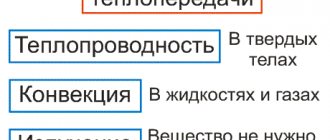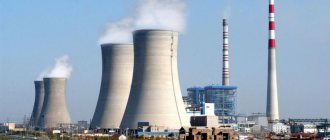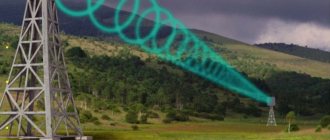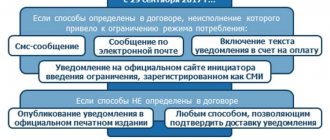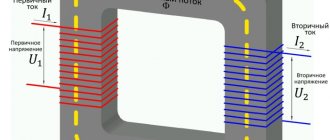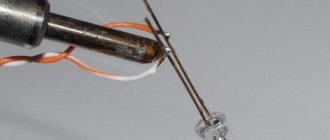Classification of electrical networks by type of current
Based on the type of current, electrical networks are traditionally divided into two types - AC and DC networks.
The most common are AC networks. Direct current is most often used to power electrified transport; direct current power supply lines are built for it. In some individual cases at industrial enterprises there is a need to build direct current power supply systems, for example, for the electrolysis of solutions or electrometallurgy, as well as in the presence of direct current electric drives.
Recently, high-voltage direct current (HVDC) power lines, which are actively used to transmit electricity from alternative energy power plants, have attracted increasing interest from designers. The advantage of such systems is their greater efficiency, the possibility of parallel operation with different direct current lines (for example, alternating current power lines with frequencies of 50 Hz and 60 Hz cannot be run in parallel), as well as the absence of the need to synchronize power line frequencies.
Stages of installation of electrical equipment
Installation of electrical equipment at an enterprise or other facility includes:
- Preparatory stage - preparation of wiring units and lighting lines, preparation of routes for laying wires and grounding elements, installation of embedded parts for further fastening of equipment. These works are carried out simultaneously with construction and finishing activities.
- Laying cables and wiring along prepared routes, with serial connection. In industrial premises, this work is carried out in parallel with the installation of electrical equipment.
- Carrying out electrical measurements and insulation resistance measurements. Preparation of a technical report.
- Performing commissioning work:
- study of design and technical documentation;
- checking the readiness of electrical equipment for commissioning;
- searching for faults that occurred during installation;
- startup of electrical installation;
- adjustment of electrical equipment;
- preparation of the Equipment Acceptance Certificate and technical report.
When carrying out installation work, it is important to comply with all the requirements of current regulatory documents (PUE, SNIP, PTE, TNP, PTB). It is also necessary to strictly follow the decisions and parameters specified in the project and technical documentation, and strictly adhere to the installation requirements set out in the instructions for the equipment.
Classification of electrical networks by voltage
Based on voltage, electrical networks are classically divided into two types - up to 1000 V and above 1000 V. To avoid confusion and ease of operation of serial electrical products in AC installations, the following voltage standards have been adopted:
- Up to 1000 V – 127 V, 220 V, 380 V, 660 V;
- Above 1000 V – 3 kV, 6 kV, 10 kV, 20 kV, 35 kV, 110 kV, 150 kV, 220 kV, 330 kV, 500 kV, 750 kV;
Under normal operating conditions, electrical receivers, depending on their purpose, allow strictly limited voltage deviations from its nominal value. To maintain voltages at a given level, it is necessary to compensate for its loss in transformers. It is for this purpose that the rated voltages of generators, as well as the secondary windings of transformers, have ratings that are 5% higher than those of electrical receivers.
For local lighting networks, low voltages can be used, namely 12 V, 24 V, 36 V.
Electric motor installation technology
The engine can be delivered to the installation site directly from the manufacturer, from the warehouse and after repair work. It can be installed on a steel or cast iron plate, a welded metal frame, a special slide or bracket. All these elements must be aligned along the axes of the engine installation in a horizontal plane and secured with foundation bolts. Holes for them are usually made during construction work, if this is provided for in the working design. In this case, plugs made of wood are left in the required places in advance.
Classification of electrical networks by purpose
According to their purpose, electrical networks are divided into distribution and supply.
A supply line is a line that supplies power to a substation (S) or distribution point (DP) from a power center (CP) without distributing electrical energy along its length.
Distribution line - a line that supplies power to a number of transformer substations from the distribution center or central processing unit.
In networks with voltages up to 1000 V, supply lines are lines that go from transformer substations to distribution boards or points, and distribution lines are called lines that go directly from distribution boards or points to power receivers.
Below is a high voltage distribution diagram with the presence of a supply and distribution network (a)) and only a distribution network (b)):
High voltage networks are constructed in cases where the voltage source is located quite a long distance away or there are a large number of transformer substations that are significantly distant from each other, for example, when supplying electricity to large industrial enterprises or cities.
High voltage as a way to reduce losses
Despite the fact that the internal networks of most consumers, as a rule, have 220/380 V, electricity is transmitted to them via high-voltage mains and reduced at transformer substations. There are good reasons for this operating scheme; the fact is that the largest share of losses occurs due to heating of the wires.
Power loss is described by the following formula: Q = I2 * Rl,
where I is the current strength passing through the line, RL is its resistance.
Based on the above formula, we can conclude that costs can be reduced by reducing the resistance in power lines or by lowering the current. In the first case, it will be necessary to increase the cross-section of the wire; this is unacceptable, since it will lead to a significant increase in the cost of power transmission lines. By choosing the second option, you will need to increase the voltage, that is, the introduction of high-voltage power lines leads to a reduction in power losses.
Classification of electrical networks according to the principle of construction
According to the principle of construction, electrical networks are divided into closed and open.
An open network is a set of open lines receiving power from one common power source IP on one side (figure below):
Its main disadvantage is the interruption of power to all electrical receivers in the area where the outage occurred due to a line break.
In a closed system, the opposite is true - power comes from two power supply sources and if the main line breaks anywhere, the power supply to the electrical receivers will not stop. The simplest diagram of a closed network is shown below:
For example, in the event of a line break at point K, power receivers 1,2,3,4 will receive power from the upper line, and 5,6,7,8 from the bottom. Depending on the requirements for reliability of power supply, closed systems may have one or more power sources. Below is an example of a circuit with two-way power supply:
Installation nuances
Electrical installation work begins with planning. The main task is to find a rational installation option. The complex amount of work begins with drawing up a network schedule. It indicates the list of work that needs to be performed, the sequence and duration of completion, and their relationship. After approval of the network schedule, electrical equipment installers begin work.
In the case of carrying out work on the power supply of an apartment, private house, office or other objects, first of all the circuit diagram is studied. Next, all the necessary system components are purchased and delivered to the work site, the technology for installing electrical equipment, the necessary tools and control devices are selected.
In an apartment or private house, household equipment is connected taking into account its energy consumption. In addition, you must adhere to these basic rules:
- wires are laid only horizontally and vertically;
- electricity meters, switches, sockets, distribution boxes and equipment must be installed so that they are easy to maintain;
- the number of sockets must be at least 1 for every 6 m2 of room, in the kitchen - at least 3, regardless of its area;
- connections and branches of wires must be mounted in junction and branch boxes;
- A separate line is installed to power powerful electrical equipment.
Elements of overhead power lines
There are always conversations between specialists in which special terms relating to power lines are used. For the uninitiated in the subtleties of slang, it is quite difficult to understand this conversation. Therefore, we offer a definition of these terms.
- The route is the axis of the power transmission line, which runs along the surface of the earth.
- PC – pickets. Essentially, these are sections of the power line route. Their length depends on the terrain and the rated voltage of the route. Zero picket is the beginning of the route.
- The construction of a support is indicated by a center sign. This is the center of the support installation.
- Picketing is essentially a simple installation of pickets.
- The span is the distance between the supports, or more precisely, between their centers.
- The sag is the delta between the lowest point of the wire sag and the strictly tensioned line between the supports.
- The wire size is again the distance between the lowest point of the sag and the highest point of the engineering structures running under the wires.
- Loop or train. This is the part of the wire that connects the wires of adjacent spans on the anchor support.
Cable power lines
Next, we move on to consider such a concept as cable power lines. Let's start with the fact that these are not bare wires that are used in overhead power lines, these are cables enclosed in insulation. Typically, cable power lines are several lines installed next to each other in a parallel direction. The cable length is not enough for this, so couplings are installed between sections. By the way, you can often find oil-filled cable power lines, so such networks are often equipped with special low-fill equipment and an alarm system that responds to oil pressure inside the cable.
If we talk about the classification of cable lines, they are identical to the classification of overhead lines. There are distinctive features, but not many of them. Basically, these two categories differ from each other in the method of installation, as well as design features. For example, according to the type of installation, cable power lines are divided into underground, underwater and by structure.
cable line
The first two positions are clear, but what applies to the “structures” position?
- Cable tunnels. These are special closed corridors in which cables are laid along installed support structures. You can walk freely in such tunnels while installing, repairing and maintaining power lines.
- Cable channels. Most often they are buried or partially buried channels. They can be laid in the ground, under the floor base, or under ceilings. These are small canals in which it is impossible to walk. To check or install the cable, you will have to dismantle the ceiling.
- Cable mine. This is a vertical corridor with a rectangular cross-section. The shaft can be walk-through, that is, with the ability for a person to fit into it, for which it is equipped with a ladder. Or impassable. In this case, you can get to the cable line only by removing one of the walls of the structure.
- Cable floor. This is a technical space, usually 1.8 m high, equipped with floor slabs at the bottom and top.
- Cable power lines can also be laid in the gap between the floor slabs and the floor of the room.
- A cable block is a complex structure consisting of laying pipes and several wells.
- A chamber is an underground structure covered on top with reinforced concrete or a slab. In such a chamber, sections of cable power lines are connected with couplings.
- An overpass is a horizontal or inclined open structure. It can be above-ground or above-ground, walk-through or impassable.
- A gallery is practically the same as an overpass, only closed.
And the last classification in cable power lines is the type of insulation. In principle, there are two main types: solid insulation and liquid. The first includes insulating braids made of polymers (polyvinyl chloride, cross-linked polyethylene, ethylene-propylene rubber), as well as other types, for example, oiled paper, rubber-paper braid. Liquid insulators include petroleum oil. There are other types of insulation, for example, special gases or other types of solid materials. But they are used very rarely today.
The essence of the phenomenon
Unlike natural resources like gas, electricity cannot be pumped into storage facilities and taken from there as much as needed. Therefore, electricity generation directly depends on consumption. When there is more demand for electricity, the power plant produces more electricity.
Daily use of electricity
Thus, the transmission of electric current can be characterized as a continuous process of generation, transportation and consumption. At the state level, the transmission of electricity is a matter of strategic security and is a priority task, for the infrastructure of which huge amounts of budget funds are allocated annually.
For example, in Russia in 2022, $30 billion was spent on improving energy infrastructure.
Additional Information . Recently, the world's first Tesla electric storage station was launched in Australia. The electricity itself is produced by wind turbines, which charge a giant bank of batteries. From them, energy is already transferred to the end consumer via wires. This way, people are not left without electricity on a windless day.
Solving the problem of wind turbines by accumulating electricity
